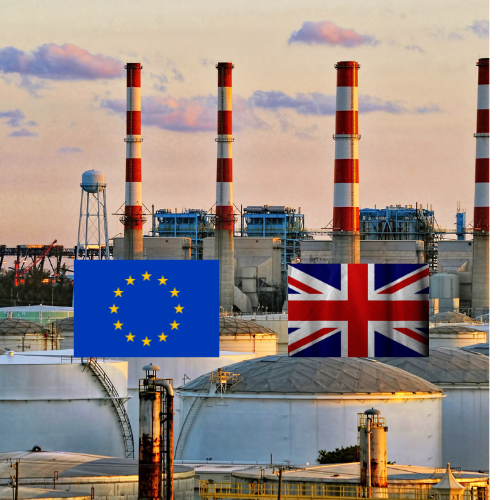This week the EU and UK announced (click here and here) that they would work towards linking their respective emissions trading systems (ETSs) and explore the possibility of reintegrating the GB power market with the EU’s internal power market.
What is it about?
- The politically fraught agreement comes as part of a broader package of measures to increase cooperation between the EU and UK post-Brexit. The linking of the respective ETS schemes will allow the carbon allowances issued by either party to be recognised for compliance under the trading scheme of the other party which would crucially allow for mutual exemptions from the respective EU and UK Carbon Border Adjustment Mechanisms (CBAMs). The CBAMs are due to enter into force in 2026 in the EU and 2027 in the UK (although the UK CBAM it is still under consultation – click here);
- Regarding energy cooperation, the parties have agreed to explore the potential for reintegrating the GB power market into the EU’s internal electricity market, including participation in the EU’s trading platforms in all timeframes including the Single Day-ahead Coupling (SDAC) and Single Intraday Coupling (SIDC) markets. The wording of the agreement makes it clear that any agreement must include “dynamic alignment” with EU rules where relevant, and appears to place arbitration powers in the hands of the EU Court of Justice. The parties have also agreed to “maximise cooperation” regarding clean energy technologies, including hydrogen, carbon capture, use and storage (CCUS), and decarbonised gases;
- Timetables for the above have not been set out in the agreement but the respective negotiations and practical implementation might take several years. Analysis of the knock-on impacts of the rules will also need to be worked through. For example, if the GB market is reintegrated into the EU internal market, what implications will this have from a REMIT compliance perspective? While the exemptions from the EU CBAM will be welcomed by some, the increased alignment of carbon prices might not be welcomed by others given that the EU’s carbon price is currently higher than the UK’s. Several industry associations and market participants have however previously signalled support for this move as this joint letter to the EU from late April indicates.
The UK Government also published this high level analysis of the potential economic benefits to the UK of linking the two ETS schemes (although it notably excludes the impact from a CBAM perspective). The EU Commission also published this Q&A on the topic.
The relevant details for energy and ETS cooperation are extracted below:
1] Energy cooperation:
a) Exploring the participation of the United Kingdom in the European Union's internal electricity market:
- The United Kingdom and the EU Commission share the view that close cooperation on electricity is in the interest of both the EU and the UK.
- The EU Commission and the UK should explore in detail the necessary parameters for the UK's possible participation in the EU's internal electricity market, including participation in the EU's trading platforms in all timeframes. Meanwhile, the current electricity trading arrangements will continue to apply.
- Regarding its territorial scope, any agreement should be appropriately articulated with the provisions of the Windsor Framework. Any agreement should be based on a balance of rights and obligations and ensure a level playing field. In this context, it should define the relationship between the UK and EU rules on the electricity market, as well as on State aid, the promotion of renewables and the protection of the environment, in so far as they relate to the electricity sector.
- Accordingly, any agreement should include dynamic alignment with EU rules where relevant, giving due regard to the UK's constitutional and parliamentary procedures and respect the role of the Court of Justice of the EU within an arbitration-based dispute resolution mechanism, and an appropriate UK contribution to decision-shaping.
b) New technologies
- The UK and the EU Commission welcome continued technical regulatory exchanges on new energy technologies such as hydrogen, carbon capture, utilisation and storage and biomethane.
2] Working towards linking Emission Trading Systems of the European Union and the United Kingdom:
- The EU Commission and the UK share the view that a functioning link between carbon markets would address many of the issues raised in respect of trade and a level playing field and would give effect to Article 392(6) of the Trade and Cooperation Agreement. This link should not constrain the EU and the UK from pursuing higher environmental ambition, consistent with their international obligations.
- Therefore, the UK and the EU Commission should work towards establishing a link between carbon markets by way of a EU-UK agreement linking the UK Emission Trading Scheme (UK ETS) and the EU Emission Trading System (EU ETS).
- Regarding its territorial scope, this agreement should be appropriately articulated with the provisions of the Windsor Framework.
- The agreement to link the UK ETS and EU ETS should create the conditions for goods originating in our jurisdictions to benefit from mutual exemptions from the respective EU and UK Carbon Border Adjustment Mechanisms subject to compliance with the relevant provisions of European Union and United Kingdom legislation.
- In terms of material scope, the agreement should cover all aspects of the functioning of an ETS link.
- The sectors falling in the scope of the ETS linking agreement should be clearly defined to avoid risks of carbon leakage and competitive distortions. Among others, this scope should include the sectors of electricity generation, industrial heat generation (excluding individual house heating), industry, domestic and international maritime transport and domestic and international aviation. The agreement should provide for a procedure to further expand the list of sectors to be covered by the linking agreement.
- Within that scope, the agreement should ensure the dynamic alignment of the UK with the relevant EU rules underpinning the functioning of the ETS link, giving due regard to the UK's constitutional and parliamentary procedures.
- The UK cap and the UK reduction pathway will be guided by the UK's Climate Change Act obligations and Nationally Determined Contributions. They should be at least as ambitious as the EU cap and the EU reduction pathway.
- The agreement should provide for an appropriate financial contribution from the UK to support the relevant costs associated with the EU's work in this policy area.
- The agreement should be subject to a dispute resolution mechanism with an independent arbitration panel that ensures the Court of Justice of the EU is the ultimate authority for all questions of EU law.
- To ensure that it can put forward its view, the UK should be involved at an early stage and contribute appropriately for a country that is not a member of the EU to the decision-shaping process of EU legal acts in the fields covered by the obligation to dynamically align. The EU Commission should consult the UK at an early stage of policy-making. These rights would not extend to participation in the work of the EU Council or its preparatory bodies.
- The agreement should be subject to a joint governance mechanism.
.png)

